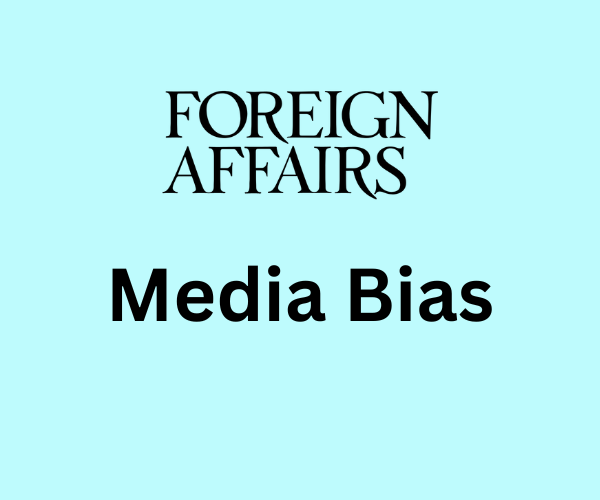
Since its inception in 1922, Foreign Affairs has been dedicated to providing serious discussion of U.S. foreign policy and international affairs to the American reader. It is a multimedia source that encapsulates a print magazine, a website, and numerous social media accounts.
In 2020, Foreign Affairs boasted an average of more than 4 minutes per visit to the ForeignAffairs.com website, which was more than double the average visit duration for the top 50 U.S. newspapers by circulation. Assuch, the question of whether Foreign Affairs is biased demands close examination.
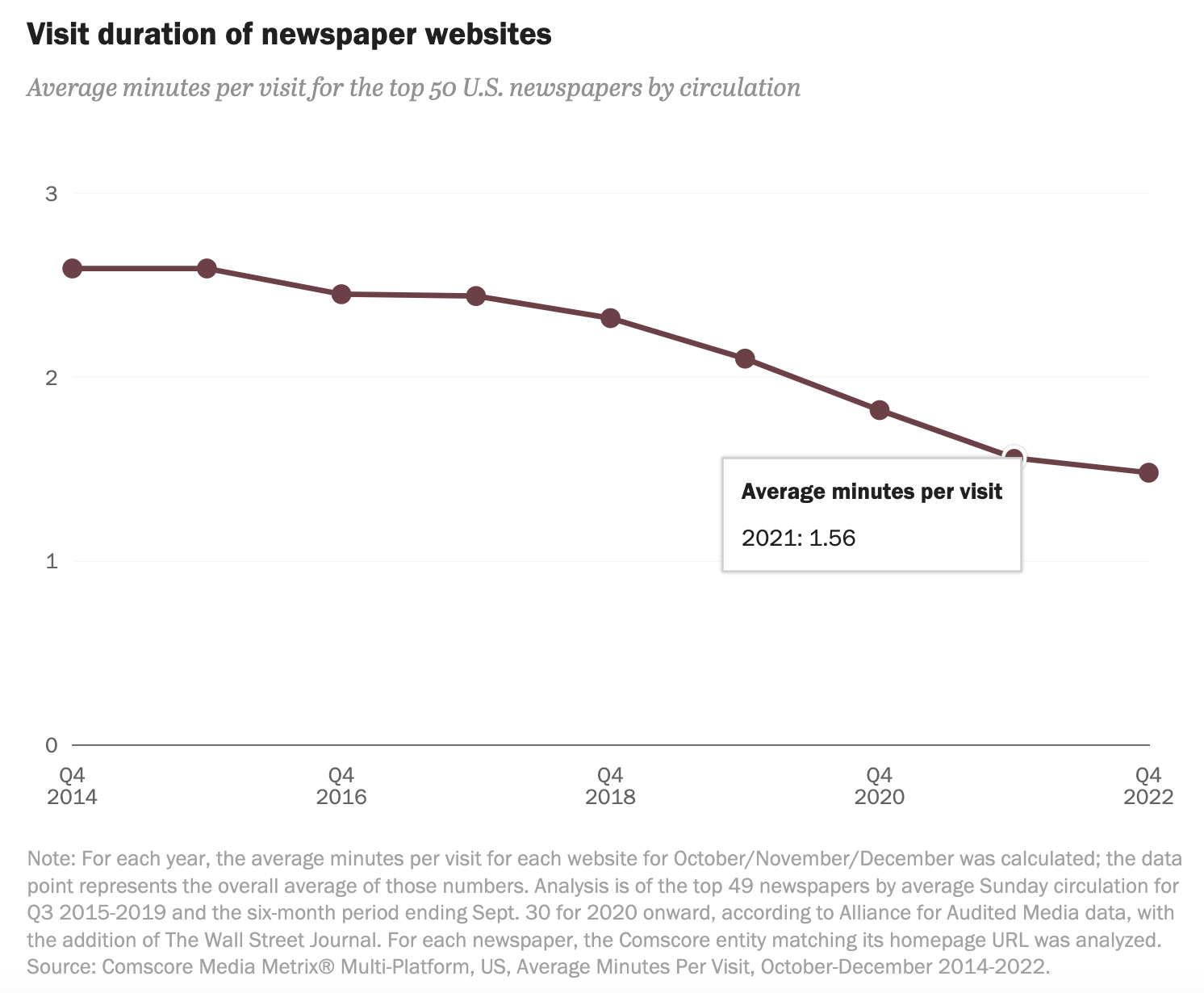
Source: Pew Research
In this article, we will analyze the magazine’s coverage and editorial decisions to determine if there is a discernible political bias in their reporting. Through our analysis, we hope to provide a comprehensive answer to whether Foreign Affairs is biased and shed light on the factors that contribute to media bias in general.
How Does Biasly Rate News Sources?
Biasly’s algorithms produce bias ratings to help provide multiple perspectives on given articles. Biasly has analyzed 200,000+ news articles from more than 3,200 news sources through our A.I. technology and team of political analysts to find the most factual, unbiased news stories.
Biasly determines the degree of political bias in news sources by using Biasly’s Bias Meter Rating, in which Biasly’s team analyzes media sources’ reliability and bias and produces three scores, a Reliability Score that measures the accuracy of media sources; an A.I. Bias Score, evaluated by A.I.; and an Analyst Bias Score evaluated by political analysts. These scores are rated based on seven rating metrics, including Tone, Tendency, Diction, Author Check, Selection/Omission, Expediency Bias, and Accuracy. These metrics help our analysts to determine the political attitude of the article.
Our A.I. machine-learning system employs natural language processing and entity-specific sentiment analysis to examine individual articles and determine their bias levels. By analyzing the key terms in an article such as policies, bias phrases, political terminologies, politicians, and their nicknames, the algorithms can rate the attitude of the text. Bias scores range from -100% and 100%, with higher negative scores being more liberal, higher positive scores being more conservative, and 0% being neutral.
Is Foreign Affairs Politically Biased?
Biasly’s rating for Foreign Affairs gives the magazine a Bias Score of Center. Biasly’s A.I. bias analysis focuses on the tone, opinion, and diction of the author. For example, Biasly’s A.I. rated Foreign Affairs’ stance on clean energy and criminal justice policies as Center. It found that both liberal and conservative politicians, such as former presidents Barack Obama and Donald Trump, were covered in a negative light.
Biasly has not yet assigned an Analyst Bias Score for Foreign Affairs. Typically, alongside the Computer Bias Score, Biasly presents an Analyst Bias Score. This score is curated based on a review of at least 15 articles by a team of analysts representing liberal, moderate, and conservative viewpoints. Different types of bias in articles, preferences for liberal or conservative politicians and policies, all factor into generating these scores. The more articles the Biasly analyst team reviews and rates, the more precise the analyst score becomes.
Before we begin, we need to discuss bias. Bias is a natural function of humans, and we can express it both consciously and unconsciously. Bias is one of the most fundamental forms of pattern recognition in humans. This isn’t to lower the bar and say that “all things are biased,” but to explain the process in which we may come to trust certain news organizations that display patterns of coverage.
On the media’s part, there is an incentive to retain audiences, encourage them to purchase subscriptions, and rate products positively. Bias is a two-way street, people want to see news stories about things they care about, and the media needs viewers to continue their operations. This creates a positive feedback loop that influences what stories are covered and from what perspective. This also explains the actions of more liberal news organizations.
Analysis of Bias in Foreign Affairs Online Articles
In 2020, MRI-Simmons found that the primary audience of Foreign Affairs tends to be college-educated, have a high household income, and be around 58 years old. Given their highly devoted and well-educated readership base, is Foreign Affairs biased? We’ll look at some of their articles in more detail below to identify the signs.
When determining bias, some of the most common metrics used include Tone, Tendency, Author, Diction, and Expediency Bias, which are the primary metrics we’ll focus on below.
- Tone: This represents the attitude of the writing, formed distinctively but related to the author’s word choices or diction.
- Diction: The specific words chosen by the writer.
- Author: A metric related to the article’s author, taking into account their history of stance on issues based on past articles and social media posts.
- Tendency measures how consistently an author shows bias in their work, including factors like their tone and perspective.
- Expediency Bias relates to the immediate impression created by elements like the article’s headline, images, or summary, indicating if they favor a particular viewpoint.
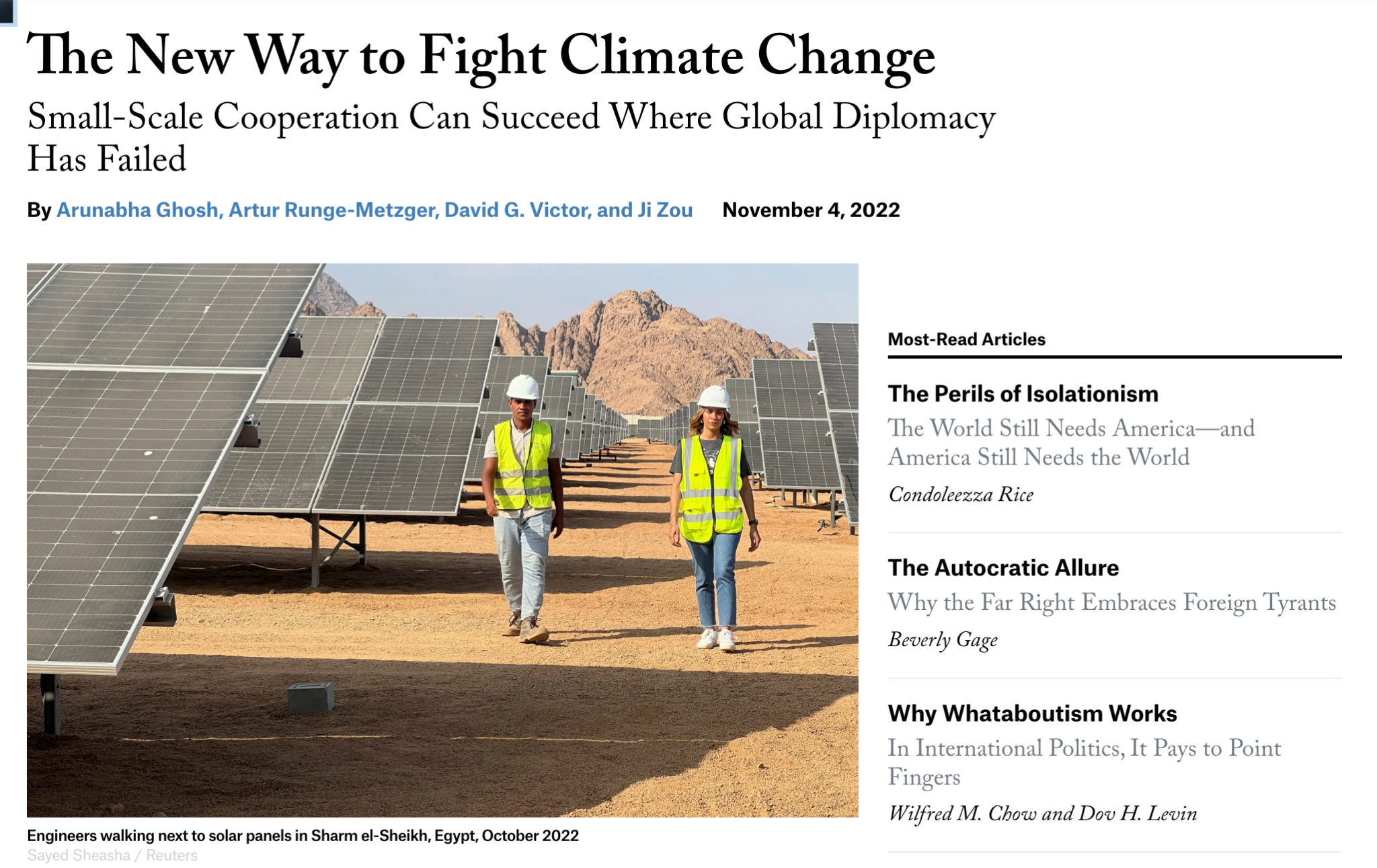
Source: Foreign Affairs
Consider this article, “The New Way to Fight Climate Change,” which Biasly has rated as Center. The title and subtitle convey plainly that the focus of this article will be small-scale cooperation as a means for fighting climate change and do not express a tone. The focal image is two engineers, not politicians or government workers, walking among solar panels with neutral expressions on their faces. As far as expediency bias, when the reader first opens this article, they do not get the impression that the co-authors have a specific viewpoint that they want to convince the readers to share.
The first line of the article is a factual statement that does not impose a feeling or perspective on the reader:
“Over the last three decades, diplomats from around the world have convened 26 times at the annual Conference of the Parties to plot out their fight against climate change.”
This diction is cut-and-dry, leaving out any emotional words or biased descriptions. This language is consistent throughout the article, as the authors continue to set-the-scene for the Conference of Parties and highlight policy issues that are likely to be discussed there. For example, when describing reducing carbon emissions, the authors write:
“The chief culprit in climate change, carbon dioxide, is an intrinsic byproduct of how the entire world uses energy, and it lingers in the atmosphere and the oceans for thousands of years.”
This sentence is void of an opinionated tone or explosive diction and only serves to describe to the reader what carbon dioxide is, which is important for understanding the following paragraphs where the authors describe how different governments are trying to cut down on carbon emissions.
Notably, this article has four co-authors, all of whose brief biographies and Foreign Affairs’ profiles are linked out to at the bottom of the page.
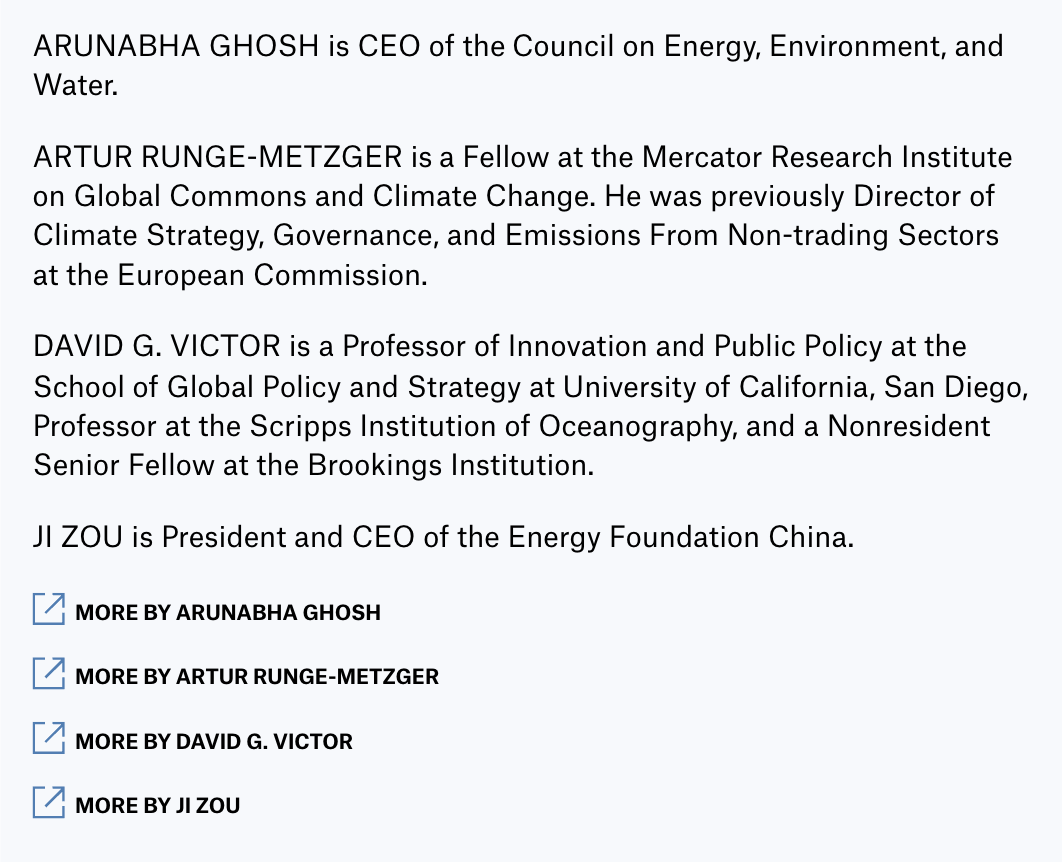
Source: Foreign Affairs
The authors come from diverse backgrounds and areas of study, which makes this article more reliable since there are international experts from three different continents weighing in on the topic of global diplomacy in regards to climate change. For Runge-Metzger and Zou, this is their first published article in Foreign Affairs, whereas Ghosh and Victor have multiple contributions to the magazine on other climate-related socio-political issues. Victor’s most recent article titled “Capitalism’s Green Revolution” does suggest that he is more fiscally conservative, as the article champions private finance for its decarbonization efforts.
In summary, the authors strive for objectivity in this article and included mostly neutral statements that provided necessary context for a discussion about climate change, which aligns with our analysis of the Foreign Affairs as a company with a tendency to lean center in its biases.
Even though this article is mostly center, bias can differ between articles and authors within the same organization. This shows the importance of looking for the signs of bias — including (but not limited to) tone, tendency, diction, author, and expediency bias — in any article you come across.
Analysis of Foreign Affairs Opinion Articles
Before we answer this question, we need to draw the distinction between opinion and reporting. While reporting is intended to be neutral, giving the reader the facts and quotes from primary sources to let them form their own opinion, opinions are an outlet for columnists to express their personal views on the issues of the day. As a magazine that publishes bi-monthly, Foreign Affairs contains mostly opinion articles and not reporting. There is no separate Opinion category, but there is a Public Opinion topic on the website that contains a high number of articles across their various Article Types, including Snapshots, Essays, and Ask the Experts.
Consider the public opinion articles “The Case for Progressive Realism” and “Why NATO Should Stay Out of Asia.” The titles of both of these articles are loaded with bias, as the authors clearly state what policies they are in support of and make it clear that they intend to use the article to convince the reader to share this opinion.
These articles are only a small representation of all of Foreign Affairs content, but they indicate that the outlet is often characterized by a great deal of opinion, which is evident even when glancing at article titles on the website’s home page. This further underscores the importance of knowing how to distinguish subjective writing from genuine reporting.
Who Owns Foreign Affairs?
Foreign Affairs is published by the Council on Foreign Relations—an independent, nonpartisan membership organization that informs its members of world events and American foreign policy. The Council was founded in 1921 and is incorporated under New York State law. It notably does not take policy positions but rather funds research to provide thoughtful analysis. The Council is managed by its Board of Directors, with Chairman David M. Rubenstein and President Michael Froman at the forefront. Rubenstein previously served as deputy assistant to President Jimmy Carter for domestic policy, and Froman served in President Barack Obama’s cabinet as the U.S. trade representative.
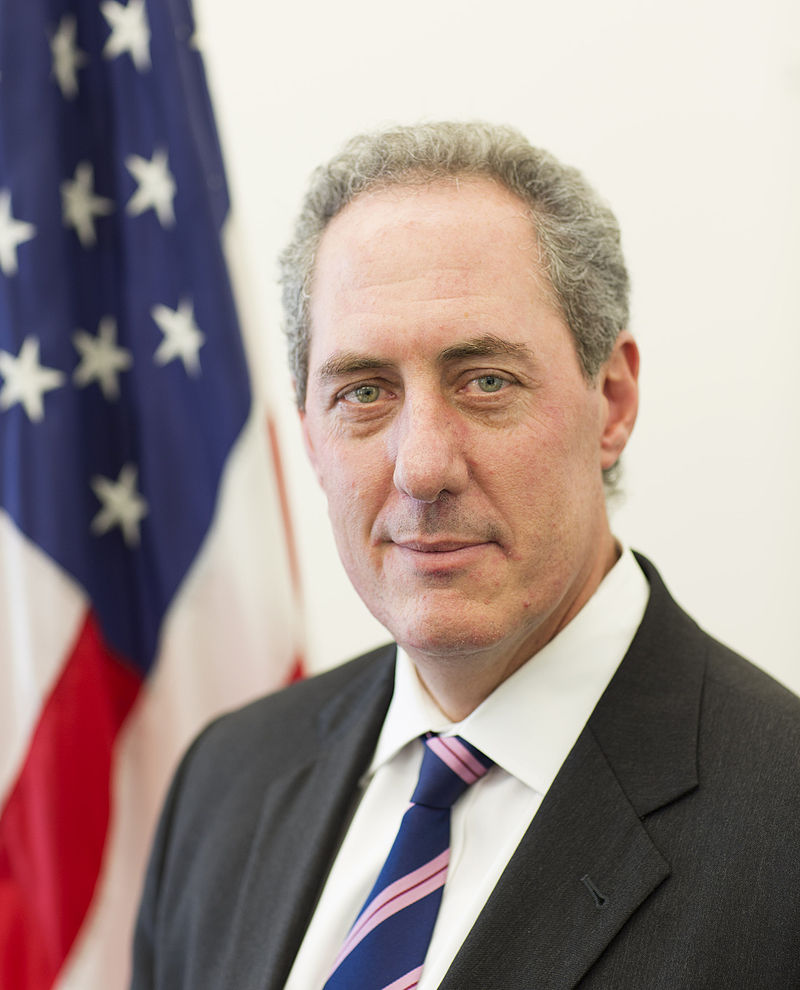
Michael Forman, Public Domain

David Rubensteinm, Source: Wikimedia Commons
The Council on Foreign Relations appoints the editor of Foreign Affairs, who is currently Dan Kurtz-Phelan. Notably, Kurtz-Phelan is the author of The China Mission, a narrative history of George Marshall’s post–World War II mission to China. His social media presence on X (formerly Twitter) involves reposting Foreign Affairs articles rather than sharing his own personal opinions.
How to Evaluate and Uncover Bias
It can often be difficult to tell if the news you watch is biased. If you have settled on a news channel, it’s usually because you trust the information you are gaining. Unfortunately, many trust the information they are hearing because it confirms what they already believe. This is referred to as “confirmation bias.” It is important to challenge your beliefs and get third-party verification that what you are hearing is the full story. This is why we recommend using Biasly to compare different news stories side-by-side using our bias ratings to figure out what both sides think of a political issue.
Although Biasly’s A.I. Bias Score gave Foreign Affairs a Center score, it is important to remember that this does not suggest that the magazine publishes mostly unbiased articles. Rather, it shows that because Foreign Affairs publishes articles that are strongly biased in liberal and conservative ways, when averaged, the score is Center because the magazine gives voice to both sides of the aisle evenly. Additionally, some article types will inherently have more or less bias; general news articles are known for being less biased than opinion pieces, which Foreign Affairs publishes a lot of. And while every article you read will be biased to some degree, some stick to the facts better than others, which is why it’s so important to use Biasly’s News Check to help you determine the bias of what you read.






















